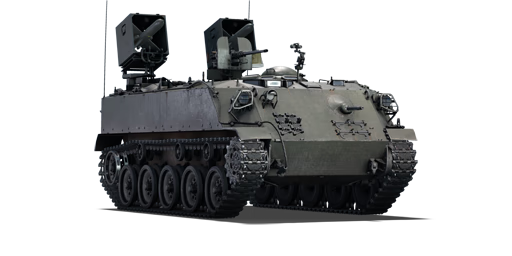

Ground Vehicles
Type 60 ATM
IV
Rank
AB
6.7
RB
6.7
SB
6.7
Battle rating
Japan
Research country
Tank destroyer
Main role
35,000

Research
210,000

Purchase
General information
The Type 60 ATM was a missile-armed APC to motorize Japan's new development in anti-tank measures, the Type 64 MAT ATGM, which was armed on a multitude of vehicles.
The Type 60 ATM was introduced in Update 1.67 "Assault". It comes with plenty of disadvantages to work with, with minimal armour, and missiles that fly by wire, swapping vehicle control to missile control, and have very slow speed due to only being a gen 1 missile. However, this can be turned into an advantage considering the missiles fly in an upwards arc, allowing the Type 60 to hide behind solid cover and manoeuvre the missile around or over obstacles relatively easily.
Camouflages
Survivability and armour
Armour
front / side / back
Hull
20 / 12 / 20 mm
Turret
0 / 0 / 0 mm
Visibility
70 %
Crew
6 persons
Mobility
Max speed
Forward
4549 km/h
Backward
910 km/h
Power-to-weight ratio
18.316.332.126 hp/t
Engine power
220195385312 hp
Weight
12 t
Optics
Gunner
Commander
Driver
Optics zoom
7.2x–8.0x
—
—
Armaments
2 x Type 64 MAT ATGM
Ammunition
6 rounds
Reload
basic crew → aces
13 → 10 s
Fire on the move
up to 5 km/h
| Ammunition | Type | Armor penetration (mm) at a distance: | |||||
|---|---|---|---|---|---|---|---|
| 10 m | 100 m | 500 m | 1000 m | 1500 m | 2000 m | ||
| ATGM | 500 | 500 | 500 | 500 | 500 | 500 | |
12.7 mm M2HB machine gun
Ammunition
800 rounds
Belt capacity
100 rounds
Reload
basic crew → aces
10.4 → 8 s
Fire rate
575 shots/min
Vertical guidance
-5 / 25°
Horizontal guidance
-45 / 45°
Turret Rotation Speed
basic crew → aces
Horizontal
6393.2 → 90133.2 °/s
Vertical
63153.7 → 90219.6 °/s
| Belt | Belt filling | Armor penetration (mm) at a distance: | |||||
|---|---|---|---|---|---|---|---|
| 10 m | 100 m | 500 m | 1000 m | 1500 m | 2000 m | ||
| API-T/I/AP/API-T | 31 | 29 | 21 | 14 | 9 | 6 | |
7.62 mm M1919A4 machine gun (coaxial)
Ammunition
1,500 rounds
Belt capacity
250 rounds
Reload
basic crew → aces
10.4 → 8 s
Fire rate
500 shots/min
| Belt | Belt filling | Armor penetration (mm) at a distance: | |||||
|---|---|---|---|---|---|---|---|
| 10 m | 100 m | 500 m | 1000 m | 1500 m | 2000 m | ||
| AP/T | 13 | 12 | 7 | 3 | 2 | 0 | |
Economy
Repair cost
Basic → Reference
AB
4,115 → 5,066 

RB
4,659 → 5,735 

SB
6,667 → 8,207 

Crew training
61,000 

Experts
210,000 

Aces
890 

Research Aces
570,000 

Reward multiplier
AB / RB / SB
130 / 200 / 250 % 

178 % 

Total cost of modifications
61,400 

102,200 

Talisman cost
1,800 

Research order:
Mobility | |
|---|---|
Protection |
|---|
Firepower |
|---|
Rating by players
You must play more than 3 battles for the last week and more than 10 battles in a vehicle to rate it.
Like:
20
Armor protection:
Not enough ratings
Survivability:
Not enough ratings
Mobility:
Not enough ratings
Armament:
Not enough ratings
Balance:
Not enough ratings
Tips & Tricks
This space is currently empty
Do you know any interesting vehicle features?
Loading...
No articles about this vehicle yet
Become the first author and get rewards!
Write a guide, tell about interesting historical facts, make a tutorial or simply an interesting post.
No more content